中国古代建筑-宫廷
中国古代宫殿建筑分析
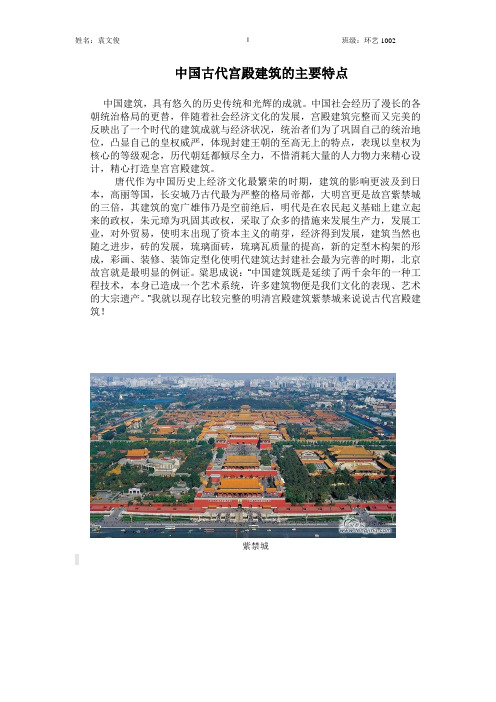
中国古代宫殿建筑的主要特点中国建筑,具有悠久的历史传统和光辉的成就。
中国社会经历了漫长的各朝统治格局的更替,伴随着社会经济文化的发展,宫殿建筑完整而又完美的反映出了一个时代的建筑成就与经济状况,统治者们为了巩固自己的统治地位,凸显自己的皇权威严,体现封建王朝的至高无上的特点,表现以皇权为核心的等级观念,历代朝廷都倾尽全力,不惜消耗大量的人力物力来精心设计,精心打造皇宫宫殿建筑。
唐代作为中国历史上经济文化最繁荣的时期,建筑的影响更波及到日本,高丽等国,长安城乃古代最为严整的格局帝都,大明宫更是故宫紫禁城的三倍,其建筑的宽广雄伟乃是空前绝后,明代是在农民起义基础上建立起来的政权,朱元璋为巩固其政权,采取了众多的措施来发展生产力,发展工业,对外贸易,使明末出现了资本主义的萌芽,经济得到发展,建筑当然也随之进步,砖的发展,琉璃面砖,琉璃瓦质量的提高,新的定型木构架的形成,彩画、装修、装饰定型化使明代建筑达封建社会最为完善的时期,北京故宫就是最明显的例证。
粱思成说:“中国建筑既是延续了两千余年的一种工程技术,本身已造成一个艺术系统,许多建筑物便是我们文化的表现、艺术的大宗遗产。
”我就以现存比较完整的明清宫殿建筑紫禁城来说说古代宫殿建筑!紫禁城紫禁城布局原则1. 中轴对称紫禁城宫殿建筑作为古典建筑的重要代表,明清时期宫殿规划的另一个重要原则是中轴对称。
古人尚中观念在宫殿营造上得到严格执行,重要建筑从南至北依次排开,布局严谨,秩序井然。
明清紫禁城的前朝三大殿、后三宫以及重要宫门、广场均分布在中轴线上,附属建筑位于两侧,这种布局充分体现了古代社会皇权的至高无上和唯我独尊。
2.前朝后寝紫禁城在宫殿建筑中这项原则在周朝时已基本形成,一直延续下来。
前朝在古代称为“朝政用房”,后寝称为“寝居用房”。
从历代皇宫建筑群的规划可以看到,帝王处理朝政的殿堂总是建在宫殿的前面,生活起居以及娱乐部分总是建在后面,明清紫禁城的规划就是一个典范。
中国古代宫廷建筑的特点

中国古代宫廷建筑的特点中国古代宫廷建筑是中国古代文化的重要组成部分,具有独特的特点和风格。
其特点主要体现在以下几个方面:1. 建筑布局合理。
中国古代宫廷建筑注重布局的合理性和对称性。
宫廷建筑一般按照南北轴线布局,前后有序排列,形成一条中轴线。
整个宫廷建筑群以主殿为中心,左右对称地布置着次殿、偏殿、厢房等建筑,形成了严谨的布局。
2. 建筑形式独特。
中国古代宫廷建筑注重形式的独特性,追求雄伟庄重、典雅精美的外观。
宫殿建筑常采用重檐歇山顶或重檐抬梁顶的屋顶形式,以及彩绘斗拱、翘角、飞檐、斗栱等装饰手法,展现了中国古代建筑的独特风格。
3. 建筑材料丰富多样。
中国古代宫廷建筑使用了丰富多样的材料,如木材、砖石、瓦片等。
其中,木材是主要的建筑材料,常用的是楠木和雪松木,因其质地坚硬、耐腐蚀而被广泛使用。
砖石则用于建造基础和墙体,砖石结构坚固耐久。
4. 建筑装饰繁复精美。
中国古代宫廷建筑的装饰非常繁复精美,注重细节的雕刻和彩绘。
宫殿的门窗、梁柱、栏杆等处常常有精美的雕刻和彩绘,如龙凤、花鸟、云纹等图案,展现了中国古代建筑的独特魅力。
5. 建筑与环境的和谐统一。
中国古代宫廷建筑注重与自然环境的和谐统一。
宫殿建筑一般选址于自然环境优美的地方,如山水之间、湖泊边等。
同时,宫廷建筑也注重与周围园林、景观的协调,形成了一种宜人的环境氛围。
6. 建筑功能齐全。
中国古代宫廷建筑功能齐全,不仅是帝王居住之所,还包括了办公、娱乐、祭祀等各种功能。
宫殿建筑群中有主殿、次殿、偏殿、花园等,每个建筑都有特定的功能和用途,形成了一个完整的宫廷建筑体系。
总体来说,中国古代宫廷建筑独特而精美,体现了中国古代建筑艺术的高度成就。
其合理的布局、独特的形式、丰富的材料、精美的装饰以及与环境的和谐统一,都使得中国古代宫廷建筑成为世界建筑史上的瑰宝。
在今天,这些古代宫廷建筑依然吸引着人们的目光,成为了重要的文化遗产和旅游景点。
中国古建筑欣赏2--宫殿
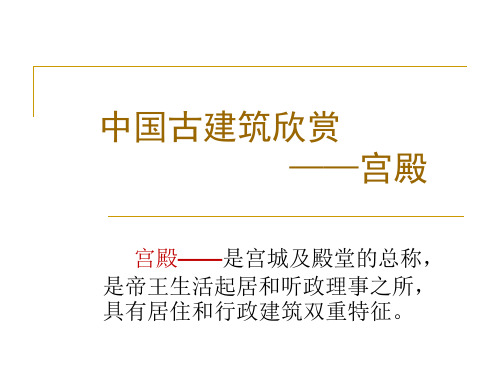
宫殿建筑的四个发展阶段
宫殿建筑的四个发展阶段
殷商宫廷建筑的营造成就
方向的测定。(半坡下,以东向为主) 四阿重屋的创造。(《考工记》:“殷人重屋。”) 青铜构件与饰件。 建筑石雕。 织物装饰:堂被锦绣。 土砌块的推广。 木结构。
宫殿建筑的四个发展阶段
二、盛行高台宫室的阶段;
以土木结构为核心的土木混合结构,四面 依靠夯土墩台建屋,台顶上再建主体殿堂。 摆脱茅茨土阶进入一个新时期。
瓦在西周只应用于檐部和屋脊等重要部位, 到春秋战国时才广泛应用于宫殿建筑;
陕西咸阳宫遗址1号复原
宫殿建筑的四个发展阶段
陕西咸阳宫遗址1号复原
宫殿建筑的四个发展阶段
宫殿建筑的四个发展阶段
三、宏伟的前殿和宫苑相结合的阶段;
池沼、台殿、树木,布局自由,富有园林气息; 前殿又称为主殿,中央用于大朝,两侧用于常朝(东 西厢制度,后来发展为两晋、南北朝时期的东西堂制 度),并非周代采用的 “三朝纵列”的方式。 前殿宏伟,如汉代长安的主要宫殿——未央宫,前殿 台基残高14米左右,南北长350米左右,东西宽约200 米。
隋大兴宫—唐太极宫
掖庭宫是宫女居住和犯罪 官僚家属妇女劳动之处。大致 分三个区域,中部为宫女居住 区,其中也包括犯罪官僚家属 妇女。掖庭宫的北部为太仓, 西南部为内侍省所在地。内侍 省是宦官机构。
பைடு நூலகம்
隋大兴宫—唐太极宫
太极宫是初唐政事 活动的中心,高祖、太 宗在这里君临天下,成 就了一代圣制,“贞观之 治”政令皆由此地发出, 贞观君臣论政的许多著 名故事也都发生在这里。 高宗龙朔以后,政事活 动中心东移大明宫,然 中宗、睿宗、玄宗、僖 宗与昭宗仍有部分时间 在西内听政,这里仍保 留着唐代重要的政治中 心地位。
中国古代宫廷建筑
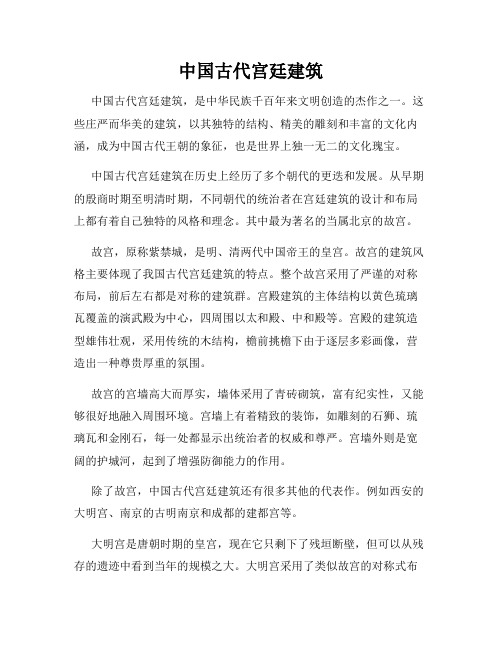
中国古代宫廷建筑中国古代宫廷建筑,是中华民族千百年来文明创造的杰作之一。
这些庄严而华美的建筑,以其独特的结构、精美的雕刻和丰富的文化内涵,成为中国古代王朝的象征,也是世界上独一无二的文化瑰宝。
中国古代宫廷建筑在历史上经历了多个朝代的更迭和发展。
从早期的殷商时期至明清时期,不同朝代的统治者在宫廷建筑的设计和布局上都有着自己独特的风格和理念。
其中最为著名的当属北京的故宫。
故宫,原称紫禁城,是明、清两代中国帝王的皇宫。
故宫的建筑风格主要体现了我国古代宫廷建筑的特点。
整个故宫采用了严谨的对称布局,前后左右都是对称的建筑群。
宫殿建筑的主体结构以黄色琉璃瓦覆盖的演武殿为中心,四周围以太和殿、中和殿等。
宫殿的建筑造型雄伟壮观,采用传统的木结构,檐前挑檐下由于逐层多彩画像,营造出一种尊贵厚重的氛围。
故宫的宫墙高大而厚实,墙体采用了青砖砌筑,富有纪实性,又能够很好地融入周围环境。
宫墙上有着精致的装饰,如雕刻的石狮、琉璃瓦和金刚石,每一处都显示出统治者的权威和尊严。
宫墙外则是宽阔的护城河,起到了增强防御能力的作用。
除了故宫,中国古代宫廷建筑还有很多其他的代表作。
例如西安的大明宫、南京的古明南京和成都的建都宫等。
大明宫是唐朝时期的皇宫,现在它只剩下了残垣断壁,但可以从残存的遗迹中看到当年的规模之大。
大明宫采用了类似故宫的对称式布局,整个宫殿建筑的风格更加典雅庄重,修建精细,代表了唐代皇家建筑的极致。
古明南京则是南宋时期的皇宫。
与大明宫相比,古明南京的风格更偏向南方的民族建筑,宫殿建筑轻盈而精致。
整座建筑群以望江楼为中心,周围种满了花草树木,形成了一种独特的景观。
建都宫是明代时期明成祖朱棣迁都成都所建的宫殿,它的布局也是严谨的对称式。
建都宫的建筑造型与故宫相似,但略显简约。
建都宫依山傍水,背倚青山,前依成华河,地理环境得天独厚,宫殿建筑与自然风景完美结合。
中国古代宫廷建筑在设计、材料选择、装饰等方面都体现出了高超的工艺和丰富的文化内涵。
中国建筑艺术-宫殿建筑ppt课件
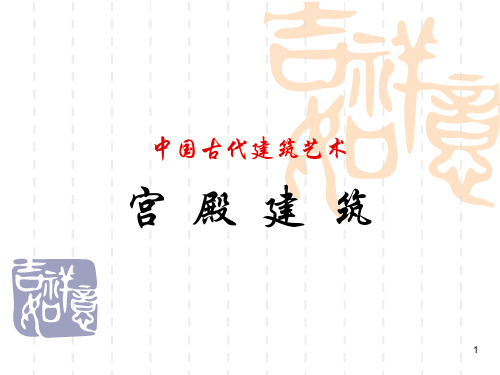
1、徐福宫
25
位于阿须贺神社内的徐福宫
上图为秦咸阳宫建筑遗址中 “一号宫殿”的复原想像;
下图为其剖面;
右图为“四号宫殿”遗址。
26
阿房宫的铺地砖
上有“海内皆臣,岁登成熟, 道毋饥人”的模印字样
27
2、建章宫 未央宫
未央宫位于西汉长安城西南,整个宫殿占地 东西2150米,南北2250米,平面约为方形, 面积5平方公里,占全城面积的1/7。
北京新建皇宫的格局仿照了南京的明初宫殿, 规模却更加壮观宏伟。清入主中国后建都于 北京,且继承沿用了明代宫殿。
48
一、北京故宫
明清宫殿继承了宋元宫殿的一些特点,总体布局原 则依然延续历代宫殿所遵循的“三朝五门”制度, 同时也有所调整和发展。这主要表现为简化院落层 次,突出主要殿宇在宫殿建筑群中的地位,进而强 化宫殿空间序列的艺术感染力。
民,富有四海的气势。 宫殿建筑中的内部空间处理也以“尊王”为准则。 用象征的手法突出皇帝的尊严。
4
2、明伦以示礼
通过建筑等级的划分维护君尊臣 卑的伦序,以突出君王的神圣和 崇高。
表现: 建筑布局 屋顶的式样 建筑装饰和技术
5
垂脊兽和兽吻
6
中国传统宫殿建筑的布局特征
1、象天设都
“象天设都”,指模仿天象安排宫殿 建筑的布局。
41
严山寺南殿内的宫殿建筑壁画
42
元代的宫3
我国著名的古建筑 学家傅熹年根据相 关文献和建筑实例, 经过比较严密的计 算,复原设计了元 大都宫殿主殿大明 殿。从复原设计图 上可以看到,大明 殿是一组工字殿, 前殿后楼,楼后出 香阁。
49
故宫占地面 积0.72平方公里。 建筑面积近0.16 平方公里。有房 屋九千多间。其 建筑规模之大, 风格之美,装饰 之辉煌,陈设之 豪华,为世所罕 见。
宫殿建筑
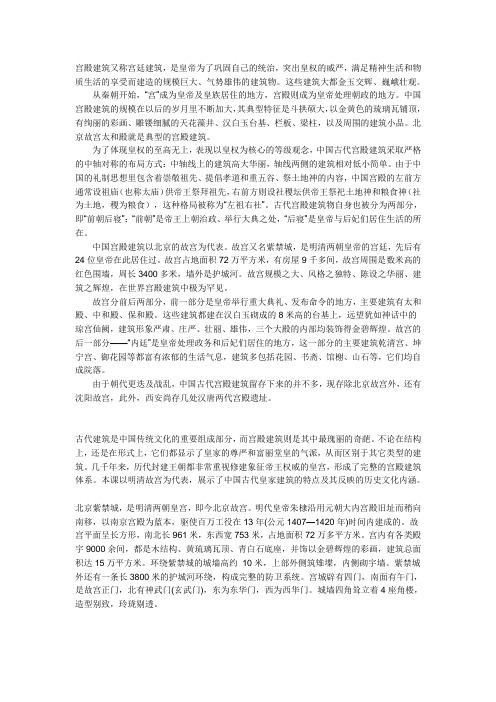
宫殿建筑又称宫廷建筑,是皇帝为了巩固自己的统治,突出皇权的威严,满足精神生活和物质生活的享受而建造的规模巨大、气势雄伟的建筑物。
这些建筑大都金玉交辉、巍峨壮观。
从秦朝开始,“宫”成为皇帝及皇族居住的地方,宫殿则成为皇帝处理朝政的地方。
中国宫殿建筑的规模在以后的岁月里不断加大,其典型特征是斗拱硕大,以金黄色的琉璃瓦铺顶,有绚丽的彩画、雕镂细腻的天花藻井、汉白玉台基、栏板、梁柱,以及周围的建筑小品。
北京故宫太和殿就是典型的宫殿建筑。
为了体现皇权的至高无上,表现以皇权为核心的等级观念,中国古代宫殿建筑采取严格的中轴对称的布局方式:中轴线上的建筑高大华丽,轴线两侧的建筑相对低小简单。
由于中国的礼制思想里包含着崇敬祖先、提倡孝道和重五谷、祭土地神的内容,中国宫殿的左前方通常设祖庙(也称太庙)供帝王祭拜祖先,右前方则设社稷坛供帝王祭祀土地神和粮食神(社为土地,稷为粮食),这种格局被称为“左祖右社”。
古代宫殿建筑物自身也被分为两部分,即“前朝后寝”:“前朝”是帝王上朝治政、举行大典之处,“后寝”是皇帝与后妃们居住生活的所在。
中国宫殿建筑以北京的故宫为代表。
故宫又名紫禁城,是明清两朝皇帝的宫廷,先后有24位皇帝在此居住过。
故宫占地面积72万平方米,有房屋9千多间,故宫周围是数米高的红色围墙,周长3400多米,墙外是护城河。
故宫规模之大、风格之独特、陈设之华丽、建筑之辉煌,在世界宫殿建筑中极为罕见。
故宫分前后两部分,前一部分是皇帝举行重大典礼、发布命令的地方,主要建筑有太和殿、中和殿、保和殿。
这些建筑都建在汉白玉砌成的8米高的台基上,远望犹如神话中的琼宫仙阙,建筑形象严肃、庄严、壮丽、雄伟,三个大殿的内部均装饰得金碧辉煌。
故宫的后一部分——“内廷”是皇帝处理政务和后妃们居住的地方,这一部分的主要建筑乾清宫、坤宁宫、御花园等都富有浓郁的生活气息,建筑多包括花园、书斋、馆榭、山石等,它们均自成院落。
由于朝代更迭及战乱,中国古代宫殿建筑留存下来的并不多,现存除北京故宫外,还有沈阳故宫,此外,西安尚存几处汉唐两代宫殿遗址。
故宫的宫廷建筑与科学方法

故宫的宫廷建筑与科学方法故宫,又称紫禁城,是中国古代宫廷建筑的杰出代表,它不仅在艺术和文化上具有极高的价值,而且在建筑技术和科学方法上也体现了古代中国的智慧和创新。
以下是一篇关于故宫宫廷建筑与科学方法的简短作文。
---**故宫的宫廷建筑与科学方法**故宫,这座历经六百年风雨的皇家宫殿,不仅以其宏伟壮丽的建筑群落和丰富的文化内涵吸引着世人的目光,更以其精湛的建筑技艺和科学方法展示了古代中国建筑的卓越成就。
首先,故宫的选址和布局体现了古代的风水学说。
紫禁城位于北京城的中心,背靠景山,面向太和殿,整个建筑群落沿中轴线对称布局,既符合“天人合一”的哲学思想,也展现了皇权的至高无上。
其次,故宫的建筑设计和施工采用了多种科学方法。
例如,太和殿的屋顶采用了“斗拱”结构,这种结构不仅美观,而且能有效分散屋顶的重量,增强建筑的稳定性。
此外,故宫的建筑材料经过精心挑选和处理,如木材需经过防腐、防虫处理,砖瓦则经过高温烧制,以确保建筑的耐久性。
再者,故宫的建筑装饰同样蕴含着科学原理。
如宫殿的彩绘、雕刻等装饰艺术,不仅美观,还具有防潮、防腐的功能。
而宫殿中的铜器、玉器等装饰品,也体现了古代工匠对材料特性的深刻理解和运用。
最后,故宫的建筑还融入了古代的天文、地理等知识。
例如,宫殿的朝向、门窗的位置等都与太阳的运行规律相吻合,以确保宫殿内部的采光和通风。
总之,故宫的宫廷建筑不仅是中国古代建筑艺术的瑰宝,更是古代科学方法在建筑领域的生动实践。
它让我们深刻体会到,古代中国人在追求美的同时,也不忘科学与实用,这种精神值得我们学习和传承。
---这篇作文简要介绍了故宫建筑的科学方法,包括选址布局、建筑结构、材料选择、装饰艺术以及天文地理知识的融合,展现了故宫建筑的科学性和实用性。
中国历史上有哪些著名的宫殿建筑
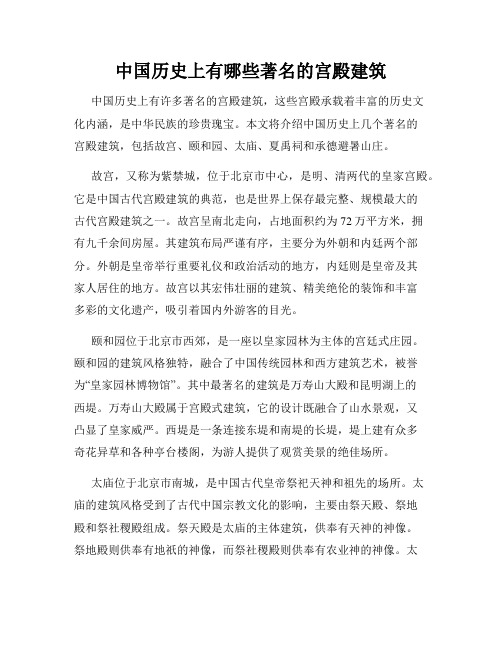
中国历史上有哪些著名的宫殿建筑中国历史上有许多著名的宫殿建筑,这些宫殿承载着丰富的历史文化内涵,是中华民族的珍贵瑰宝。
本文将介绍中国历史上几个著名的宫殿建筑,包括故宫、颐和园、太庙、夏禹祠和承德避暑山庄。
故宫,又称为紫禁城,位于北京市中心,是明、清两代的皇家宫殿。
它是中国古代宫殿建筑的典范,也是世界上保存最完整、规模最大的古代宫殿建筑之一。
故宫呈南北走向,占地面积约为72万平方米,拥有九千余间房屋。
其建筑布局严谨有序,主要分为外朝和内廷两个部分。
外朝是皇帝举行重要礼仪和政治活动的地方,内廷则是皇帝及其家人居住的地方。
故宫以其宏伟壮丽的建筑、精美绝伦的装饰和丰富多彩的文化遗产,吸引着国内外游客的目光。
颐和园位于北京市西郊,是一座以皇家园林为主体的宫廷式庄园。
颐和园的建筑风格独特,融合了中国传统园林和西方建筑艺术,被誉为“皇家园林博物馆”。
其中最著名的建筑是万寿山大殿和昆明湖上的西堤。
万寿山大殿属于宫殿式建筑,它的设计既融合了山水景观,又凸显了皇家威严。
西堤是一条连接东堤和南堤的长堤,堤上建有众多奇花异草和各种亭台楼阁,为游人提供了观赏美景的绝佳场所。
太庙位于北京市南城,是中国古代皇帝祭祀天神和祖先的场所。
太庙的建筑风格受到了古代中国宗教文化的影响,主要由祭天殿、祭地殿和祭社稷殿组成。
祭天殿是太庙的主体建筑,供奉有天神的神像。
祭地殿则供奉有地祇的神像,而祭社稷殿则供奉有农业神的神像。
太庙体现了中国古代帝王礼仪祭祀的深厚文化底蕴,也是中国古代建筑艺术的重要代表之一。
夏禹祠位于河南省安阳市,是中国古代纪念夏禹的重要建筑。
夏禹是中国传说中的第一个帝王,他被尊为治水英雄和中华民族的始祖。
夏禹祠是中国古代纪念英雄的典型建筑,它的主体建筑是夏庙和禹廊。
夏庙供奉有夏禹的神像,禹廊则展示了夏禹治理洪水的故事。
夏禹祠以其独特的建筑风格和文化内涵,吸引着来自各地的游客和历史爱好者。
承德避暑山庄位于河北省承德市,是中国古代皇家避暑胜地的代表。
宫殿建筑介绍及案例
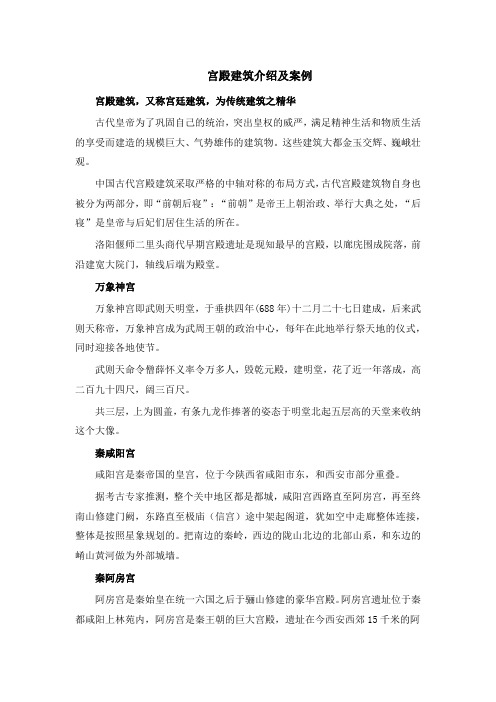
宫殿建筑介绍及案例宫殿建筑,又称宫廷建筑,为传统建筑之精华古代皇帝为了巩固自己的统治,突出皇权的威严,满足精神生活和物质生活的享受而建造的规模巨大、气势雄伟的建筑物。
这些建筑大都金玉交辉、巍峨壮观。
中国古代宫殿建筑采取严格的中轴对称的布局方式,古代宫殿建筑物自身也被分为两部分,即“前朝后寝”:“前朝”是帝王上朝治政、举行大典之处,“后寝”是皇帝与后妃们居住生活的所在。
洛阳偃师二里头商代早期宫殿遗址是现知最早的宫殿,以廊庑围成院落,前沿建宽大院门,轴线后端为殿堂。
万象神宫万象神宫即武则天明堂,于垂拱四年(688年)十二月二十七日建成,后来武则天称帝,万象神宫成为武周王朝的政治中心,每年在此地举行祭天地的仪式,同时迎接各地使节。
武则天命令僧薛怀义率令万多人,毁乾元殿,建明堂,花了近一年落成,高二百九十四尺,阔三百尺。
共三层,上为圆盖,有条九龙作捧著的姿态于明堂北起五层高的天堂来收纳这个大像。
秦咸阳宫咸阳宫是秦帝国的皇宫,位于今陕西省咸阳市东,和西安市部分重叠。
据考古专家推测,整个关中地区都是都城,咸阳宫西路直至阿房宫,再至终南山修建门阙,东路直至极庙(信宫)途中架起阁道,犹如空中走廊整体连接,整体是按照星象规划的。
把南边的秦岭,西边的陇山北边的北部山系,和东边的崤山黄河做为外部城墙。
秦阿房宫阿房宫是秦始皇在统一六国之后于骊山修建的豪华宫殿。
阿房宫遗址位于秦都咸阳上林苑内,阿房宫是秦王朝的巨大宫殿,遗址在今西安西郊15千米的阿房村一带,始建于公元前212年。
为中国重点文物保护单位。
1961年中华人民共和国国务院公布为全国重点文物保护单位。
汉长乐宫公元前202,汉高祖在秦朝兴乐宫的基础上建成的长乐宫,是为汉三宫之一。
长乐宫是西汉的政治中心,其总体上是由四组宫殿组成:长信殿、长秋殿、永寿殿、永宁殿。
长乐宫是汉高祖刘邦处理政务的地方。
在历史上,长乐宫又叫“东宫”。
长安城里有三级宫殿:长乐宫,未央宫、建章宫,合称“汉三宫”。
中国古代著名的建筑

中国古代著名的建筑
中国古代著名的建筑有很多,其中包括万里长城、故宫、颐和园、天坛、圆明园等。
这些建筑都具有浓厚的文化底蕴和历史价值,是中国古代建筑艺术的杰出代表。
万里长城是中国古代的伟大工程之一,始建于春秋时期,历经多个朝代的修建,绵延数千公里,是世界上最长的城墙。
故宫是中国明清时期的皇家宫殿,坐落在北京中心,是中国古代宫廷建筑的代表之一。
颐和园是清朝时期皇家园林,以其宏伟的建筑和美丽的景观著称于世。
天坛是明清时期皇帝祭天的场所,主要建筑有祈年殿和圜丘坛。
圆明园是清朝皇家园林,建筑风格融合了中西方文化,现已成为中国近代史上的悲剧遗址。
这些古代建筑不仅是中华民族文化的瑰宝,也是世界文化遗产,吸引了全世界的游客前来观赏。
它们不仅展示了中国古代建筑的高超技艺和美学价值,更是中华民族文化的重要组成部分,彰显了中国几千年的文化传承和独特的文化魅力。
- 1 -。
我国古代宫殿建筑特点:浅谈宫殿建筑空间布局
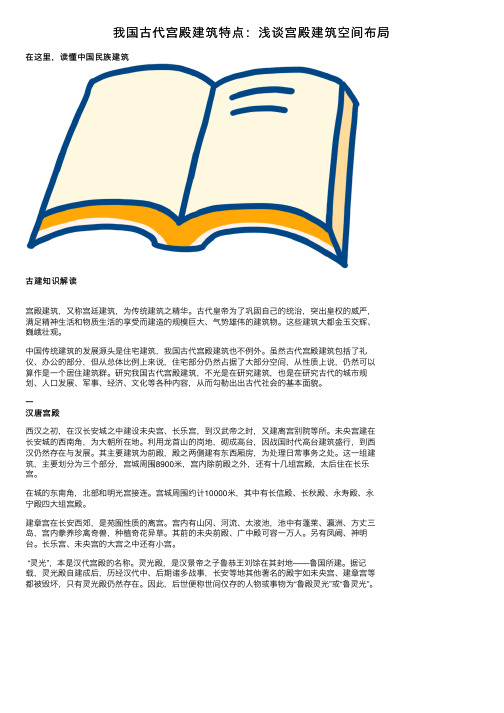
我国古代宫殿建筑特点:浅谈宫殿建筑空间布局中国民族建筑在这⾥,读懂中国民族建筑在这⾥,读懂古建知识解读宫殿建筑,⼜称宫廷建筑,为传统建筑之精华。
古代皇帝为了巩固⾃⼰的统治,突出皇权的威严,满⾜精神⽣活和物质⽣活的享受⽽建造的规模巨⼤、⽓势雄伟的建筑物。
这些建筑⼤都⾦⽟交辉、巍峨壮观。
中国传统建筑的发展源头是住宅建筑,我国古代宫殿建筑也不例外。
虽然古代宫殿建筑包括了礼仪、办公的部分,但从总体⽐例上来说,住宅部分仍然占据了⼤部分空间,从性质上说,仍然可以算作是⼀个居住建筑群。
研究我国古代宫殿建筑,不光是在研究建筑,也是在研究古代的城市规划、⼈⼝发展、军事、经济、⽂化等各种内容,从⽽勾勒出出古代社会的基本⾯貌。
⼀汉唐宫殿西汉之初,在汉长安城之中建设未央宫、长乐宫,到汉武帝之时,⼜建离宫别院等所。
未央宫建在长安城的西南⾓,为⼤朝所在地。
利⽤龙⾸⼭的岗地,砌成⾼台,因战国时代⾼台建筑盛⾏,到西汉仍然存在与发展。
其主要建筑为前殿,殿之两侧建有东西厢房,为处理⽇常事务之处。
这⼀组建筑,主要划分为三个部分,宫城周围8900⽶,宫内除前殿之外,还有⼗⼏组宫殿,太后住在长乐宫。
在城的东南⾓,北部和明光宫接连。
宫城周围约计10000⽶,其中有长信殿、长秋殿、永寿殿、永宁殿四⼤组宫殿。
建章宫在长安西郊,是苑囿性质的离宫。
宫内有⼭冈、河流、太液池,池中有蓬莱、瀛洲、⽅丈三岛,宫内豢养珍禽奇兽,种植奇花异草。
其前的未央前殿、⼴中殿可容⼀万⼈。
另有凤阙、神明台。
长乐宫、未央宫的⼤宫之中还有⼩宫。
“灵光”,本是汉代宫殿的名称。
灵光殿,是汉景帝之⼦鲁恭王刘馀在其封地——鲁国所建。
据记载,灵光殿⾃建成后,历经汉代中、后期诸多战事,长安等地其他著名的殿宇如未央宫、建章宫等都被毁坏,只有灵光殿仍然存在。
因此,后世便称世间仅存的⼈物或事物为“鲁殿灵光”或“鲁灵光”。
未央宫复原图唐代宫城在皇城之北,是皇帝听政和皇后嫔妃的居住之处,也属于宫室。
故宫建筑特色介绍

故宫建筑特色介绍故宫,是中国古代帝王的宫殿,也是世界上最大的古代皇家建筑群之一。
其建筑风格独特,反映了中国传统建筑的精髓,具有极高的历史、文化和艺术价值。
下面将从布局结构、建筑材料、装饰艺术等几个方面介绍故宫的建筑特色。
故宫的布局结构设计非常精巧。
整个故宫由一系列连续的建筑群组成,呈南北走向,中轴线贯穿其中。
中轴线上依次排列着五个宫殿,分别是午门、太和殿、中和殿、保和殿和乾清宫。
这些宫殿之间相互呼应,形成了一个有机的整体。
同时,故宫的布局还体现了中国古代哲学思想中的阴阳五行理论,强调了宇宙的和谐与平衡。
故宫的建筑材料选用了丰富多样的石材和木材。
在建筑结构中,石材被广泛应用于基础、台阶和墙体等部位,以增加建筑的稳固性。
而在宫殿的梁柱和屋顶等部位,则大量使用了木材。
这些木材选用的是上等的楠木,具有耐腐蚀、抗虫蛀和防火等特点。
此外,故宫还使用了瓦片、琉璃、彩画等材料进行装饰,使建筑更加美观。
故宫的装饰艺术表现出了中国传统建筑的独特魅力。
宫殿的外墙上经过精细的彩绘,绘有各种动植物、神话传说和历史人物等图案,色彩鲜艳、寓意深远。
而宫殿内部的装饰则更加精美,例如宫殿的梁柱上刻有精美的龙纹和云纹,寓意着皇权的神圣和至高无上。
此外,故宫还展示了丰富多样的文物和艺术品,如瓷器、玉器、书画等,展现了中国古代文化的博大精深。
故宫的建筑特色还体现在其宏伟壮观的规模上。
整个故宫占地面积约为72万平方米,建筑面积约为15万平方米,拥有近10000间房屋。
宫殿的屋顶高大宏伟,层层叠叠,形成了独特的屋脊形态。
而宫墙高大厚实,围合出一个庞大的宫廷空间。
这些规模宏大的建筑体现了中国古代帝王的权威和威严,也展示了中国古代建筑的宏伟气势。
故宫作为中国古代皇家建筑的代表,具有独特的建筑特色。
其布局结构精巧、建筑材料丰富、装饰艺术精美,体现了中国传统建筑的魅力与艺术价值。
故宫的建筑特色不仅体现了中国古代建筑的卓越成就,也成为世界文化遗产中的瑰宝。
北京故宫中国古代宫殿建筑的典范
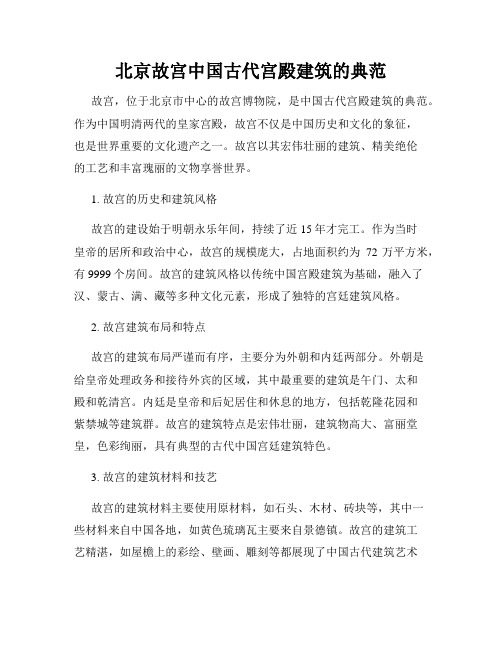
北京故宫中国古代宫殿建筑的典范故宫,位于北京市中心的故宫博物院,是中国古代宫殿建筑的典范。
作为中国明清两代的皇家宫殿,故宫不仅是中国历史和文化的象征,也是世界重要的文化遗产之一。
故宫以其宏伟壮丽的建筑、精美绝伦的工艺和丰富瑰丽的文物享誉世界。
1. 故宫的历史和建筑风格故宫的建设始于明朝永乐年间,持续了近15年才完工。
作为当时皇帝的居所和政治中心,故宫的规模庞大,占地面积约为72万平方米,有9999个房间。
故宫的建筑风格以传统中国宫殿建筑为基础,融入了汉、蒙古、满、藏等多种文化元素,形成了独特的宫廷建筑风格。
2. 故宫建筑布局和特点故宫的建筑布局严谨而有序,主要分为外朝和内廷两部分。
外朝是给皇帝处理政务和接待外宾的区域,其中最重要的建筑是午门、太和殿和乾清宫。
内廷是皇帝和后妃居住和休息的地方,包括乾隆花园和紫禁城等建筑群。
故宫的建筑特点是宏伟壮丽,建筑物高大、富丽堂皇,色彩绚丽,具有典型的古代中国宫廷建筑特色。
3. 故宫的建筑材料和技艺故宫的建筑材料主要使用原材料,如石头、木材、砖块等,其中一些材料来自中国各地,如黄色琉璃瓦主要来自景德镇。
故宫的建筑工艺精湛,如屋檐上的彩绘、壁画、雕刻等都展现了中国古代建筑艺术的高超技巧。
这些艺术细节反映了中国古代建筑注重细节和精细雕琢的传统。
4. 故宫的文物收藏和文化价值故宫收藏了大量珍贵的文物,包括绘画、书法、陶瓷、玉器、金器等。
这些文物不仅展示了中国古代艺术的精品,也是了解中国历史和文化的重要途径。
故宫的文物收藏之丰富和品质之高在世界范围内都属罕见,被誉为东方博物馆。
5. 故宫的影响和保护工作故宫不仅在中国具有重要的地位,也对世界文化遗产产生了深远影响。
它的建筑风格和设计理念对许多东亚国家的宫殿建筑产生了影响。
为了保护故宫的建筑和文物,中国政府投入大量资金和人力进行保护和修复工作,并加强了相关法律法规的执行。
总结:作为中国古代宫殿建筑的杰作,北京故宫以其独特的建筑风格、精湛的工艺和丰富的文物收藏,展现了中华民族悠久的历史和灿烂的文化。
故宫的宫廷建筑与社会

故宫的宫廷建筑与社会
故宫,又称紫禁城,是中国古代宫廷建筑的杰出代表,位于中国北京市中心,曾是明清两代的皇家宫殿,承载着丰富的历史与文化价值。
以下是一篇关于故宫宫廷建筑与社会关系的简短作文。
---
**故宫的宫廷建筑与社会**
故宫,这座古老的宫殿,不仅以其宏伟壮丽的建筑群和精美的艺术收藏闻名于世,更深刻地反映了中国古代社会的等级制度和皇权至上的思想。
走进故宫,首先映入眼帘的是那高大的城墙和庄严的城门,它们象征着皇权的至高无上和不可侵犯。
城墙之内,宫殿林立,层层叠叠,布局严谨,体现了古代中国对秩序和等级的重视。
太和殿、中和殿、保和殿等主要建筑,不仅在规模上显得宏伟壮观,更在细节上展现了精湛的工艺和深厚的文化底蕴。
宫廷建筑的装饰艺术,如雕刻、绘画、瓷器等,无不透露着皇家的奢华与精致。
这些艺术品不仅美化了宫廷,也是社会地位和权力的象征。
例如,龙的形象在宫廷中随处可见,它不仅是皇权的象征,也是中华民族的图腾。
故宫的建筑和收藏品,不仅是历史的见证,也是社会文化的传承。
它们让我们得以窥见古代中国社会的面貌,理解那个时代的价值观和社会结构。
同时,故宫作为世界文化遗产,也是连接过去与现在,中国与世界的桥梁,吸引着来自世界各地的游客,促进了文化交流与理解。
总之,故宫的宫廷建筑不仅是中国古代建筑艺术的瑰宝,也是社会历史的缩影。
它们让我们更加深刻地认识到,建筑不仅是空间的创造,更是文化和社会的表达。
---
这篇作文简要介绍了故宫的建筑特点,以及它们如何反映古代中国的社会结构和文化价值。
希望这能为你的写作提供一些灵感。
故宫建筑特色介绍
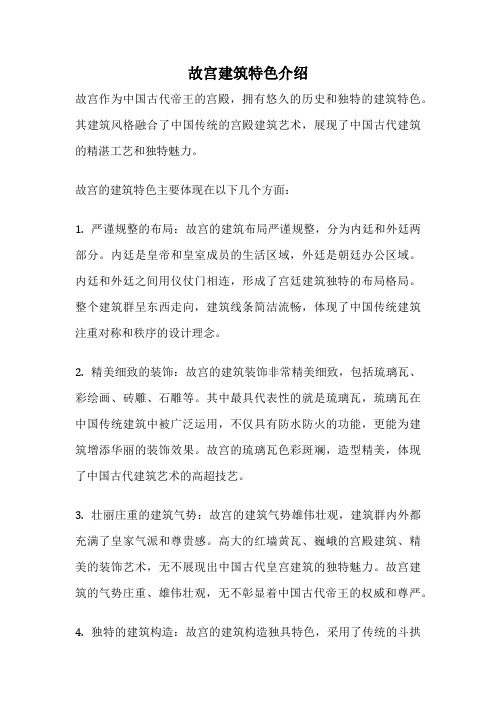
故宫建筑特色介绍故宫作为中国古代帝王的宫殿,拥有悠久的历史和独特的建筑特色。
其建筑风格融合了中国传统的宫殿建筑艺术,展现了中国古代建筑的精湛工艺和独特魅力。
故宫的建筑特色主要体现在以下几个方面:1. 严谨规整的布局:故宫的建筑布局严谨规整,分为内廷和外廷两部分。
内廷是皇帝和皇室成员的生活区域,外廷是朝廷办公区域。
内廷和外廷之间用仪仗门相连,形成了宫廷建筑独特的布局格局。
整个建筑群呈东西走向,建筑线条简洁流畅,体现了中国传统建筑注重对称和秩序的设计理念。
2. 精美细致的装饰:故宫的建筑装饰非常精美细致,包括琉璃瓦、彩绘画、砖雕、石雕等。
其中最具代表性的就是琉璃瓦,琉璃瓦在中国传统建筑中被广泛运用,不仅具有防水防火的功能,更能为建筑增添华丽的装饰效果。
故宫的琉璃瓦色彩斑斓,造型精美,体现了中国古代建筑艺术的高超技艺。
3. 壮丽庄重的建筑气势:故宫的建筑气势雄伟壮观,建筑群内外都充满了皇家气派和尊贵感。
高大的红墙黄瓦、巍峨的宫殿建筑、精美的装饰艺术,无不展现出中国古代皇宫建筑的独特魅力。
故宫建筑的气势庄重、雄伟壮观,无不彰显着中国古代帝王的权威和尊严。
4. 独特的建筑构造:故宫的建筑构造独具特色,采用了传统的斗拱结构和木结构,建筑风格古朴典雅。
斗拱是中国古代建筑的一个重要构件,不仅能加强建筑的稳固性,更能为建筑增添一种特有的美感。
故宫的斗拱结构精湛复杂,体现了中国古代木结构建筑工艺的高超水平。
总的来说,故宫作为中国古代皇宫的代表,其建筑特色体现了中国传统建筑的精湛工艺和独特风格。
故宫的建筑规整布局、精美装饰、庄重气势和独特构造,无不展现了中国古代建筑艺术的独特魅力,吸引着世界各地的游客前来观赏。
故宫建筑的美丽壮观,不仅是中国古代建筑的杰作,更是中华文明的重要载体,传承着中华民族悠久的历史和文化传统。
中国古代的宫廷艺术与建筑
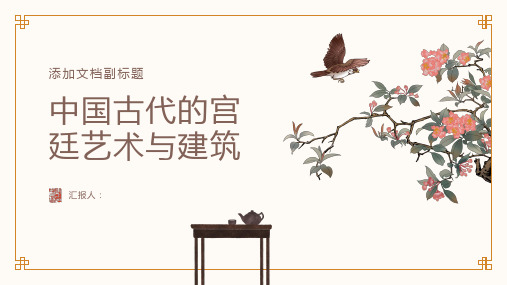
壁画:描绘历史故事、神话传说,展现 皇家气派
家具:采用名贵木材,雕刻精美,彰显 皇家气派
装饰品:玉器、瓷器、金银器等,体现 皇家财富和品味
布局:对称布局,体现皇权的威严和庄 重
皇家园林的特色与风格
布局:讲究对称,中轴线明确 建筑风格:富丽堂皇,气势恢宏 园林景观:山水相映,花木繁茂 功能:集观赏、休闲、娱乐于一体
建筑价值:展示 了中国古代宫廷 建筑的独特风格 和精湛技艺,对 于研究古代建筑 史和建筑理论具 有重要价值。
社会价值与政治价值
社会价值:宫廷 艺术与建筑是中 国古代社会文化 的重要组成部分, 反映了当时的社 会风貌和审美情 趣。
政治价值:宫廷 艺术与建筑是皇 权的象征,体现 了皇帝的权威和 地位,同时也反 映了当时的政治 制度和政治文化。
陶瓷作品
唐三彩:唐代陶瓷艺术的代表作品,色彩丰富,造型优美 青花瓷:元代至清代的陶瓷艺术代表作品,以蓝白相间的图案为主 粉彩瓷:清代的陶瓷艺术代表作品,色彩柔和,图案细腻 珐琅彩瓷:清代的陶瓷艺术代表作品,色彩鲜艳,图案精美
玉器作品
玉器作品包括玉雕、玉器皿、 玉佩等
玉器是中国古代宫廷艺术的 重要组成部分
历史价值与文化价值
历史价值:反映 了中国古代宫廷 艺术的发展历程 和特点,具有重 要的历史研究价 值。
文化价值:体现 了中国古代宫廷 文化的独特魅力 和审美情趣,对 于传承和弘扬中 华优秀传统文化 具有重要意义。
艺术价值:展示 了中国古代宫廷 艺术的精湛技艺 和独特风格,对 于研究古代艺术 史和艺术理论具 有重要价值。
艺术价值与审美价值
宫廷艺术与建筑 是中国古代文化 的重要组成部分, 具有极高的艺术 价值。
中国古代十大经典建筑

六、 祭祀性建筑-代表性建筑:北京四坛 京有四坛,名唤:天、地、日、月,相互对照。呈对称分布在 紫禁城的东南西北,镇守着老皇宫紫禁城。
七、 桥梁及水利建筑-代表性建筑:卢沟桥 卢沟桥因横跨卢沟河(即永定河)而得名,是北京市现存最古老的石造联拱桥。 为华北最长的古代石桥。桥身两侧石雕护栏各有望柱140根,柱头上均雕有卧伏 的大小石狮共501个,神态各异,栩栩如生。桥东的碑亭内立有清乾隆题“卢沟 晓月”汉白玉碑。
五、 园囿建筑-代表性建筑:苏州园林 苏州园林又称“苏州古典园林”,以私家园林为主。起始于春秋时期,形成于五代, 成熟于宋代,兴旺鼎盛于明清。1997年,被列入《世界遗产名录》,被胜誉为“咫 尺之内再造乾坤”。拙政园、留园、网师园和环秀山庄,以其意境深远、构筑精致、 艺术高雅、而成为苏州古典园林的典范。
中国古代十大经典建筑
一、 宫廷府第建筑-代表性建筑:故宫 北京故宫,旧称紫禁城。位于北京中轴线的中心,是明清两个朝代的皇宫。 是世界上现存规模最大、保存最为完整的木质结构的宫殿型建筑。
二、 防御守卫建筑-代表性建筑:长城
长城始建于周朝。历代长城总长度为21196.18千米,长城墙体、 壕堑、单体建筑、关堡和相关设施等长城遗产43721处。
八、 民居建筑-代表性建筑:徽派建筑 徽派建筑在总体布局上,依山就势,构思精巧,自然得体;在平面布局上规模 灵活,变幻无穷;在空间结构上,造型丰富,讲究韵律美,以马头墙、小青瓦 最有特色;在建筑雕刻艺术的综合运用上,融石雕、木雕、砖雕为一体,显得 富丽堂皇。
九、 宗教建筑-代表性建筑:布达拉宫 布达拉宫是一座宫堡式建筑群,最初是迎娶尺尊公主和文成公主而兴建。 于17世纪重建后,成为历代达赖喇嘛的冬宫居所。1994年,布达拉宫被 列为世界文化遗产,主体建筑为白宫和红宫两部分。它起建于山腰,大 面积的石壁又屹立如削壁,使建筑仿佛与山岗融为一体,气势雄伟,距 今已有1300年的历史。
- 1、下载文档前请自行甄别文档内容的完整性,平台不提供额外的编辑、内容补充、找答案等附加服务。
- 2、"仅部分预览"的文档,不可在线预览部分如存在完整性等问题,可反馈申请退款(可完整预览的文档不适用该条件!)。
- 3、如文档侵犯您的权益,请联系客服反馈,我们会尽快为您处理(人工客服工作时间:9:00-18:30)。
中国古代建筑-宫廷-6
中文:
数字九在古代中国有特殊的含义。
人们认为奇数代表阳(yang)而偶数表阴(yin)。
因为九是十以下最大的奇数,它被认为是及其幸运的数字,所以,皇帝们喜欢独占这个数字,用它来象征他们的高高在上。
和九有关的设计几乎出现在每座皇家(imperial)建筑上,比如说,在紫荆城(the Forbidden City)的大门上,有81个镀金铜饰钉(gold-plated bronze studs)排成九行九列。
古宫殿经常被设计为九重建筑群(complex)。
基于相同的原因,和皇家建筑有关的数字经常等于九或九的倍数。
语言要点:
odd number; even number; symbolize; superiority; related to; based on; multiple
译文:
The number nine carried a special meaning in ancient China. It was believed that odd numbers represent yang while even numbers yin. Since nine is the largest odd number under ten, it was regarded as an extremely lucky number. So emperors like to dominate it to symbolize their superiority. Designs related to nine appeared almost on every imperial structure. For example, on the gate of the Forbidden City, there are 81 gold-plated bronze studs which were arranged in nine columns and nine rows. Ancient palaces usually were designed to be nine-section architectural complexes. Based on the same reasoning, numbers related to imperial architecture often equaled or were multiples of nine.。
